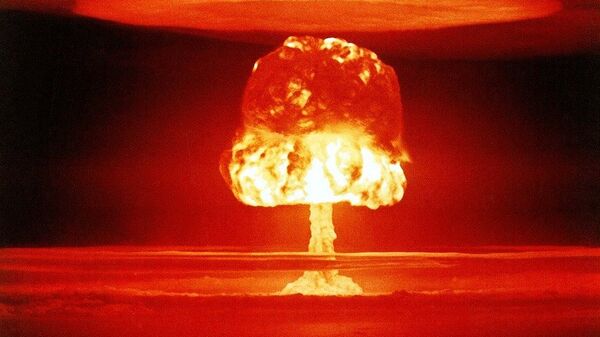Secretary of Defence Mark Esper on Friday said that the US had managed to “maintain a highly capable nuclear triad to deter conflict and deter war”.
Speaking at a virtual Pentagon meeting, Esper claimed that the country’s nuclear triad is “more capable” than that of "[US] adversaries and competitors".
He pledged that Washington would “continue to maintain that overmatch in the years ahead” by further modernising its strategic bombers, intercontinental ballistic missiles, and nuclear-powered submarines.
The remarks came a few days after the 75th anniversary of the first-ever nuclear test, during which a plutonium-based device was detonated at the Alamogordo Test Range in New Mexico. Here are some details about the test, part of the so-called Manhattan Project.
Manhattan Project
The initiative dated back to November 1939, when then-US President Franklin Roosevelt was briefed about the Third Reich developing an atom bomb which American scientists warned was fraught with unpredictable repercussions.
By June 1944, about 130,000 specialists were involved in the Manhattan Project and its budget stood at a record $2 billion at the time, something that made it possible to simultaneously carry out work in two directions pertaining to the creation of plutonium and uranium charges.
Physicist Norris Bradbury (left) with atomic bomb 'Gadget', 15 Jul 1945 pic.twitter.com/7r19CvzJuP
— ⭐Sir Joe Guybee⭐ (@JGuybee) July 15, 2020
Most of the work was implemented in the then secret city of Los Alamos, New Mexico, with General Leslie Groves and physicist Robert Oppenheimer at the helm of the project.
By the summer of 1945, the Americans created three atom bombs, nicknamed the Gadget, the Fat Man, and the Little Boy before picking the Gadget as the first-ever nuclear device to be test-fired.
Preparing the atomic bomb 'Gadget' for Operation Trinity, 15 Jul 1945 pic.twitter.com/ixx1TFUaxr
— ⭐Sir Joe Guybee⭐ (@JGuybee) July 15, 2020
It was decided to conduct the test codenamed Trinity at the Alamogordo Bombing and Gunnery Range, located about 230 miles (370 kilometres) south of Los Alamos. Residents of nearby settlements were not warned about the testing so as not to violate the secrecy regime.
A fortified command post was situated about 9 miles (16 kilometres) southwest of the test site, while most observers were in a special camp 18 miles (30 kilometres) away.
‘Lighting Up Earth and Sky’
The test was conducted on 16 July 1945 and its effect exceeded all expectations, given that the explosion’s capacity reached 21 kilotons of TNT and its crater was 76 metres in diameter. The shock wave spread over 160 kilometres, and the mushroom cloud rose to a 12-kilometre height.
75 years ago today—at 5:29:45 AM (Mountain War Time)—about 35 miles SE of Socorro, New Mexico, the nuclear age began with a big bang. Contrary to popular belief, the area surrounding the Trinity test site was not uninhabited, and the fallout did not harmlessly drift away. pic.twitter.com/8TED8UTMcz
— Stephen Schwartz (@AtomicAnalyst) July 16, 2020
William Laurence of The New York Times, who was the only journalist to witness the test, reported that it was like a “sunrise such as the world has never seen”.
He described the explosion as “a great green super-sun climbing in a fraction of a second to a height of more than 8,000 feet [2.4 km], rising ever higher until it touched the clouds, lighting up earth and sky all around with a dazzling intensity”.
It is worth noting that Soviet military intelligence was in the know about the Trinity test despite Washington's desperate attempts to keep it a secret.
The Gadget explosion was followed by the American bombings of the Japanese cities of Hiroshima and Nagasaki on 4 and 6 August 1945, respectively, during which at least 129,000 people died.



